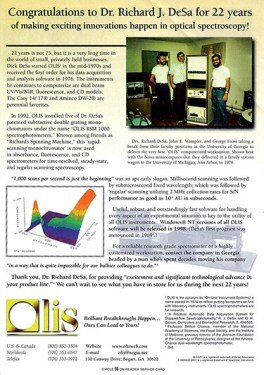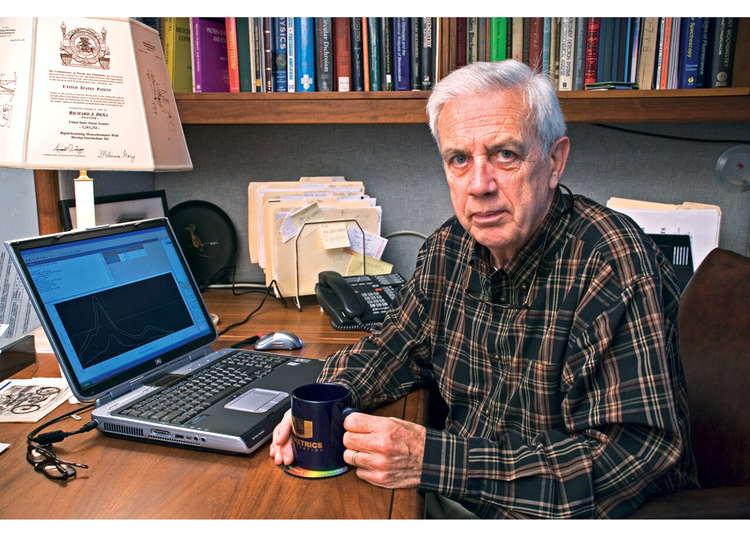Some Ideas on Circularly Polarized Luminescence You Should Know
Some Ideas on Circularly Polarized Luminescence You Should Know
Blog Article
The Single Strategy To Use For Circular Dichroism
Table of ContentsSpectrophotometers Fundamentals Explained3 Easy Facts About Spectrophotometers DescribedLittle Known Facts About Circularly Polarized Luminescence.The Facts About Spectrophotometers RevealedThe Facts About Spectrophotometers RevealedExamine This Report about Circular DichroismSome Known Questions About Circular Dichroism.Getting My Uv/vis/nir To WorkRumored Buzz on SpectrophotometersSome Known Questions About Spectrophotometers.An Unbiased View of SpectrophotometersThe Main Principles Of Uv/vis Fascination About Uv/vis
It is then scanned through the sample and the recommendation services. Portions of the occurrence wavelengths are transmitted through, or reflected from, the sample and the reference. The resultant light strikes the photodetector device, which compares the relative intensity of the two beams. Electronic circuits transform the relative currents into direct transmission percentages and/or absorbance/concentration values.The transmission of a reference compound is set as a baseline (information) value, so the transmission of all other substances are taped relative to the preliminary "zeroed" substance. The spectrophotometer then converts the transmission ratio into 'absorbency', the concentration of specific parts of the test sample relative to the preliminary compound.
Since samples in these applications are not easily offered in large amounts, they are especially matched to being analyzed in this non-destructive method. In addition, precious sample can be conserved by utilizing a micro-volume platform where as low as 1u, L of sample is required for complete analyses. A quick explanation of the treatment of spectrophotometry includes comparing the absorbency of a blank sample that does not consist of a colored compound to a sample which contains a colored compound.
Everything about Circularly Polarized Luminescence
In biochemical experiments, a chemical and/or physical home is chosen and the procedure that is utilized is specific to that residential or commercial property in order to derive more details about the sample, such as the quantity, pureness, enzyme activity, etc. Spectrophotometry can be used for a variety of strategies such as determining ideal wavelength absorbance of samples, determining ideal p, H for absorbance of samples, determining concentrations of unidentified samples, and determining the p, Ka of different samples.: 21119 Spectrophotometry is likewise a valuable procedure for protein purification and can also be used as an approach to produce optical assays of a substance.
It is possible to know the concentrations of a two part mixture utilizing the absorption spectra of the standard options of each component. To do this, it is essential to understand the extinction coefficient of this mix at 2 wave lengths and the termination coefficients of options which contain the known weights of the 2 parts.

Uv/vis Things To Know Before You Get This
The majority of spectrophotometers are used in the UV and visible regions of the spectrum, and a few of these instruments likewise run into the near-infrared area as well. The concentration of a protein can be estimated by measuring the OD at 280 nm due to the presence of tryptophan, tyrosine and phenylalanine (https://www.livebinders.com/b/3570027?tabid=514355ed-03f4-acee-f8e7-d79f6b7bffab).
This technique needs a spectrophotometer capable of determining in the UV area with quartz cuvettes.: 135 Ultraviolet-visible (UV-vis) spectroscopy involves energy levels that delight electronic transitions. Absorption of UV-vis light delights molecules that are in ground-states to their excited-states.
20. 8 O.D. Ink manufacturers, printing business, fabrics vendors, and lots of more, need the data provided through colorimetry. They take readings in the area of every 520 nanometers along the visible area, and produce a spectral reflectance curve or a data stream for alternative discussions. These curves can be used to test a new batch of colorant to inspect if it makes a match to specs, e.
The Ultimate Guide To Spectrophotometers
Traditional noticeable region spectrophotometers can not detect if a colorant or the base product has fluorescence. This can make it hard to handle color concerns if for instance several of the printing inks is fluorescent. Where a colorant contains fluorescence, a bi-spectral fluorescent spectrophotometer is utilized (http://go.bubbl.us/df2308/dba3?/New-Mind-Map). There are two major setups for visual spectrum spectrophotometers, d/8 (spherical) and 0/45.
Researchers use this instrument to determine the quantity of substances in a sample. If the compound is more focused more light will be soaked up by the sample; within little ranges, the Beer, Lambert law holds and the absorbance between samples vary with concentration linearly. When it comes to printing measurements 2 alternative settings are typically used- without/with uv filter to control better the effect of uv brighteners within the paper stock.
Our Spectrophotometers Ideas
Some applications need little volume measurements which can be carried out with micro-volume platforms. As explained in the applications section, spectrophotometry can be used in both qualitative and quantitative analysis of DNA, RNA, and proteins. Qualitative analysis can be used and spectrophotometers are used to record spectra of substances by scanning broad wavelength areas to determine the absorbance residential or commercial properties (the strength of the color) of the substance at each wavelength.

The 20-Second Trick For Spectrophotometers
One major factor is the type of photosensors that are offered for different spectral regions, but infrared measurement is likewise tough due to the fact that essentially whatever emits IR as thermal radiation, especially at wavelengths beyond about 5 m. Another problem is that rather a few products such as glass and plastic absorb infrared, making it incompatible as an optical medium.
Samples for IR spectrophotometry may be smeared between 2 discs of potassium bromide or ground with potassium bromide and pushed into a pellet. Where liquid services are to be measured, insoluble silver chloride is utilized to construct the cell. Spectroradiometers, which run nearly like the noticeable area spectrophotometers, are developed to determine the spectral density of illuminants. Retrieved Dec 23, 2018. Essential Laboratory Techniques for Biochemistry and Biotechnology (2nd ed.). The necessary guide to analytical chemistry.
Oke, J. B.; Gunn, J. E.
The Facts About Circular Dichroism Revealed

1021/ac50048a728. ISSN0003-2700. Ninfa AJ, Ballou DP, Benore M (2015 ). Essential Lab Methods for Biochemistry and Biotechnology (3, rev. ed.). Hoboken, NJ: Wiley & Sons. p. 77. ISBN9780470924525. OCLC915641828. "Totally Automatic Double Beam - Atomic Absorption Spectrophotometer (AA 8000)". Laboratory Devices. Labindia Analytical Instruments Pvt. Ltd. "Spectrophotometry Applications and Principles".
The 10-Minute Rule for Uv/vis
Obtained Jul 4, 2018. Trumbo, Toni A.; Schultz, Emeric; Borland, Michael G.; Pugh, Michael Eugene (April 27, see this site 2013). "Applied Spectrophotometry: Analysis of a Biochemical Mixture". Biochemistry and Molecular Biology Education. 41 (4 ): 24250. doi:10. 1002/bmb. 20694. PMID 23625877. (PDF). www. mt.com. Mettler-Toledo AG, Analytical. 2016. Retrieved Dec 23, 2018. Cortez, C.; Szepaniuk, A.; Gomes da Silva, L.
"Checking Out Proteins Filtration Strategies Animations as Tools for the Biochemistry Mentor". Journal of Biochemistry Education. 8 (2 ): 12. doi:. Garrett RH, Grisham CM (2013 ). Biochemistry. Belmont, CA: Cengage. p. 106. ISBN 978-1133106296. OCLC 801650341. Vacation, Ensor Roslyn (May 27, 1936). "Spectrophotometry of proteins". Biochemical Journal. 30 (10 ): 17951803. doi:10. 1042/bj0301795.
PMID 16746224. Hermannsson, Ptur G.; Vannahme, Christoph; Smith, Cameron L. C.; Srensen, Kristian T.; Kristensen, Anders (2015 ). "Refractive index dispersion noticing using an array of photonic crystal resonant reflectors". Applied Physics Letters. 107 (6 ): 061101. Bibcode:2015 Ap, Ph, L. 107f1101H. doi:10. 1063/1. 4928548. S2CID 62897708. Mavrodineanu R, Schultz JI, Menis O, eds.
Fascination About Uv/vis
U.S. Department of Commerce National Bureau of Standards special publication; 378. Washington, D.C.: U.S. National Bureau of Standards.
The process begins with a regulated light that brightens the examined sample. When it comes to reflection, as this light interacts with the sample, some is absorbed or released. The produced light journeys to the detector, which is evaluated, measured, and provided as industry-standard color scales and indices.
Market governing bodies generally specify specific metrics for specific items, such as Tomato and Coffee indices. The streamlined mathematics appears like this: Where R is the reflection coefficient. All terms are evaluated over the visible spectrum from 400 to 700 nm. In the case of transmission, when the light interacts with the sample, it is either taken in, shown, or transferred.
The Single Strategy To Use For Uv/vis
Examples include APHA (American Public Health Association) for watercolor and pureness analysis, ASTM D1500 for petrochemical color analysis, edible oil indices utilized in food, and color analyses of drinks. All terms are assessed over the noticeable spectrum from 400 to 700 nm.
Image Credit: Matej Kastelic/ Dr. Arnold J. Beckman and his colleagues at the National Technologies Laboratories first created the spectrophotometer in 1940. In 1935 Beckman founded the business, and the discovery of the spectrophotometer was their most ground-breaking creation. Dr. Bruce Merrifield, a Nobel prize-winning biochemist, stated that the invention of the spectrophotometer was "most likely the most essential instrument ever developed towards the advancement of bioscience." Before the discovery of the spectrophotometer, chemical analyses took weeks to complete, with 25% precision.
Some Of Circularly Polarized Luminescence
Over time, researchers kept improving the spectrophotometer style to enhance its performance. The UV capabilities of the model B spectrophotometer were enhanced by replacing the glass prism with a quartz prism.
After 1984, double-beam variations of the gadget were developed. The addition of external software application with the provision of onscreen screens of the spectra can be found in the 1990s. Usually, a spectrophotometer is comprised of 2 instruments, namely, a spectrometer and a photometer. A fundamental spectrophotometer includes a light source, a monochromator, a collimator for straight light beam transmission, a cuvette to position a sample, and a photoelectric detector.
4 Simple Techniques For Circularly Polarized Luminescence
There are different kinds of spectrophotometers in numerous sizes and shapes, each with its own purpose or performance. A spectrophotometer identifies just how much light is shown by chemical elements. spectrophotometers. It measures the distinction in light intensity based upon the overall amount of light presented to a sample and the quantity of beam that goes through the sample solution
Based on the instrument's design, the sample is put between the spectrometer and the photometer. After the light is gone through the sample, the photometer measures its strength and displays the reading. A spectrophotometer is used to identify the concentration of both colorless and colored solutes in a service. This instrument is used to figure out the rate of a reaction.
Report this page